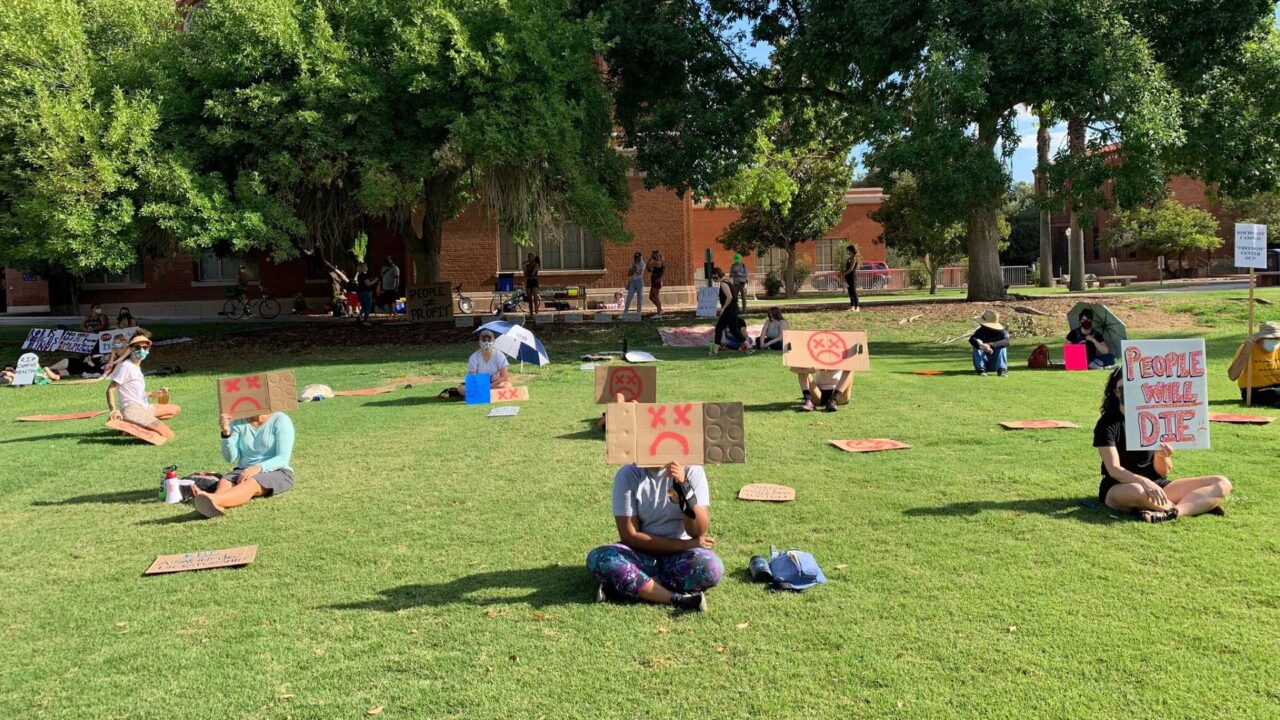Following the release of Brown President Christina Paxon’s New York Times Op-Ed, College Campuses Must Reopen in the Fall. Here’s How We Do It. in April, leaders from across the Bargaining for the Common Good network, local unions, and student and community groups circulated a letter — eventually signed by over thirty member-based organizations — putting forth a different, people- and worker-centered vision for higher education. The letter continues to serve as an organizing tool for on-the-ground efforts to protect workers, students, and our communities.
COVID 19 and the uprisings following George Floyd’s murder are a wake-up call for higher education in the U.S. Will higher ed actually deliver the promises of an equitable America, or further drive its inequality?
College and University Presidents are calling for “safely reopening campuses” to save higher education. These calls ring hollow when students, graduate student workers, faculty, staff and outsourced workers can’t get PPE and are struggling to feed their families now, when campuses are closed.
Protecting higher education as a keystone of our post-COVID 19 economy requires common sense, out-of-the-box thinking. It starts with placing workers, students, faculty and equity at the center of all decision-making – not on the chopping block.
For too long, we’ve been forced to make impossible choices between raising tuition or cutting back essential staff and services, while donors get tax breaks, endowments grow and management bloats. We’ve watched as the amenities race for football and campus Jamba Juices have left poor, black and brown workers, especially student workers, further behind.
College and University administrators must take care of the basic needs of all the humans their institutions support, not the construction loans or donors they “owe.” Even then, only a free, state-supported higher education system, fully funded by the wealthiest in this country, can lift up the next generation – it’s what we all need and deserve. We can absolutely make it happen.
To get there, we need the following short and long term solutions:
-
The Federal Government must include billions dedicated to higher education as part of the next round of COVID response legislation and higher ed should be part of the short term borrowing options being considered for states and municipalities. Just as federal stimulus attached strings to the airlines’ bailout, any federal funds dedicated to higher education must require that colleges and universities use public resources to guarantee current staffing, support for all students, full annual funding for graduate students and shifting contingent positions into full-time ones. Higher education leaders should use all their resources to make sure this happens.
-
Preserve higher education as a provider of good, family-supporting jobs by providing PPE and keeping everyone on the payroll NOW. You can’t provide a safe and secure campus to re-open when staff and faculty don’t have the tools or job security right now to make that happen. Everyone who is or will be on a College or University campus needs full PPE and the resources to keep their families’ health protected. Employees of higher education institutions are the backbone of the student experience, from janitors to adjuncts and tenured faculty – each and every one of them are critical, and layoffs only prolong this crisis’s terror and the economic recovery for all of us. Campuses should only reopen when there’s a commitment to maintain the staffing and resources (PPE, etc.) needed to keep workers and students safe.
-
Give poor, working students and students of color the support, resources and funds they need to safely stay in school: When campuses reopen, ALL students should be safe and have access to the same quality of education, including poor, working, black and brown students. We know poor students and those of color disproportionately lack access to the resources needed to attend and stay safe, from the internet to housing to funds for basic needs. Our higher ed system already inadequately compensates for these inequities through scholarships, work study and similar programs. We also know many students and staff alike felt unsafe on campus as university/college police or public safety and local law enforcement targeted communities of color. We need to develop a robust plan now that centers these students and removes barriers to them accessing all the resources they need to be both safe and successful on our campuses.
-
DO #2 and #3 By Using Rainy Day Funds: College and University Executives should use all rainy day funds, reserves, investments, endowments and other resources at their disposal to center the care of workers and students first, including continuation or extension of pay for undergraduate and graduate workers, and ensure we keep colleges and universities whole. Why do we have “rainy day funds” if not for use during a once-in-a-generation global disaster? Hundreds of thousands of people are dying – we can and we must change our system to prioritize spending money to save our lives and jobs – the lives and jobs of students, workers and community members who depend on higher education. This is why we saved billions in rainy day funds! All regents, board members and trustees should move immediately to use any and all funds needed.
-
Tax the Wealthy and Make College Free: Our society can afford to create a free higher education system that drives economic growth and creates opportunity and upward mobility for everyone. NOW is the time to realize that dream, not entrench wealth by shrinking our higher education system. We do this by ensuring the ultra rich pay their fair share and taxing the wealthy. They’ve benefited from decades of tax breaks, including through donating to higher education endowments. Every College and University Administrator, Board Member, Regent, Trustee and others in leadership positions should support wealth taxes and commit to paying their fair share themselves.
To be clear – Higher Education Presidents, Boards of Regents, Trustees, and Higher Education Leaders: Your duty now is to marshal all the resources and expertise at your disposal to make it possible not just to safely reopen campuses, but to save our colleges and universities and ensure they continue to serve as a vehicle for good jobs and economic opportunity for ALL OF US. Students, workers and our communities depend on it.
Signed
Council of University of California Faculty Associations
UPTE CWA
UC AFT
SEIU Florida Public Services Union (FPSU)
Teamsters 2010
UAW 2865
UAW 5810
AFSCME 3299
Rutgers AAUP-AFT
PSC CUNY
CIR/SEIU Committee of Interns and Residents
Professional Staff Union MTA/NEA
Portland State University (PSU) AAUP
Massachusetts Society of Professors — UMass Amherst — MSP/MTA/NEA
Temple Association of University Professionals (TAUP)
Graduate Employees’ Organization Local 3550 AFT University of Michigan
Graduate Employee Organization UAW 1596 University of Massachusetts Boston
Faculty Staff Union, University of Massachusetts Boston
Coalition of Graduate Employee Unions’ Coordinating Committee
University of Connecticut Graduate Employee Union – UAW Local 6950
Florida Student Power Network
York University Graduate Students’ Association
UCW-CWA Local 3865, Tennessee
Graduate Researchers United (GRU) AFSCME Local 402, Oregon Health & Science University
SEIU Local 1
Massachusetts Teachers Association (MTA), NEA
United Campus Workers (UCW) Kentucky, CWA Local 3365
United Campus Workers (UCW) GA, CWA local 3265
United Campus Workers (UCW) AL, CWA local 3965
UFCW Local 655, St. Louis MO
Georgetown Alliance of Graduate Employees, AFT Local 06440
Graduate Student Employees Union, SUNY
Graduate Student Employees Union, CWA Local 1104
United Campus Workers (UCW) Colorado, CWA Local 7799
SEIU 721

